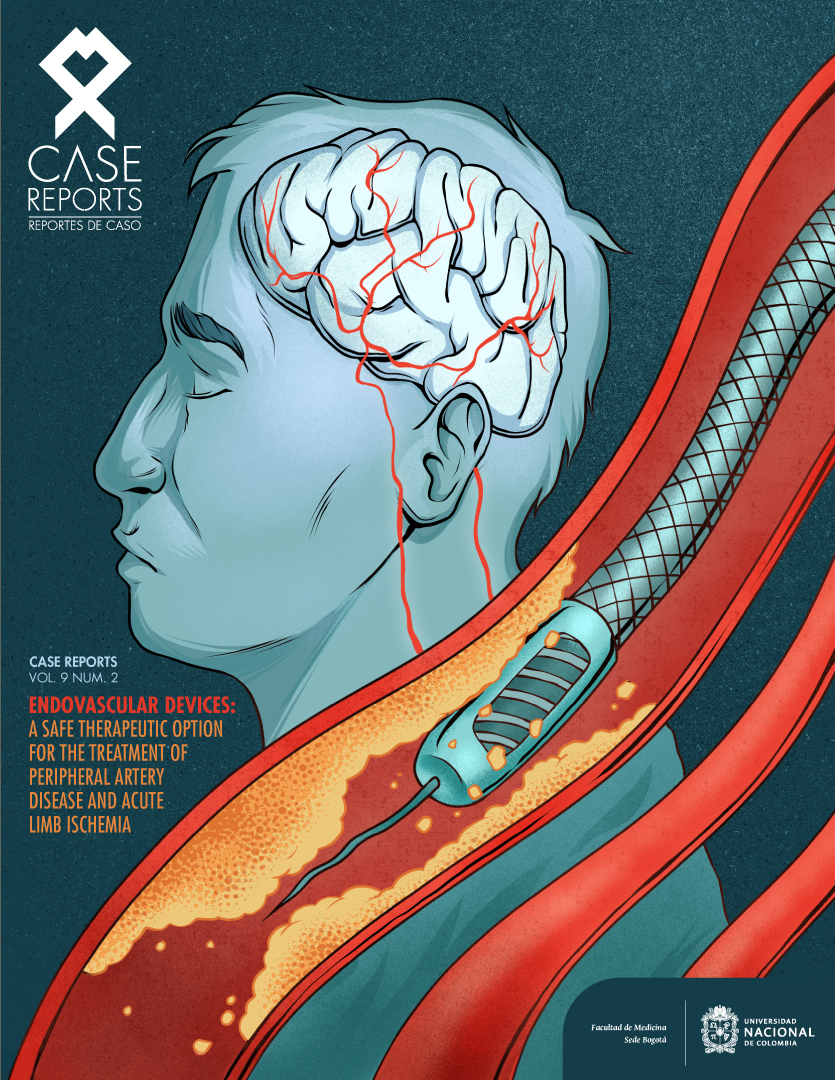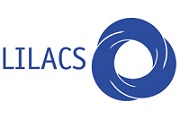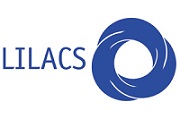Trombólisis intravenosa en el manejo del síndrome disartria-mano torpe. Reporte de caso y abordaje terapéutico
Intravenous thrombolysis for the management of dysarthria-clumsy hand syndrome. Case report and therapeutic approach
DOI:
https://doi.org/10.15446/cr.v9n2.97137Palabras clave:
Infarto cerebral, Accidente vascular cerebral lacunar, Terapia trombolítica (es)Cerebral Infarction, Stroke, Lacunar, Thrombolytic Therapy (en)
Descargas
Resumen
Introducción. Los infartos lacunares suelen tener una presentación compleja. En los pacientes con este tipo de infartos la sospecha de isquemia justifica el estudio de los síntomas neurológicos focales y la decisión de ofrecer una terapia de reperfusión que favorezca su pronóstico.
Presentación del caso. Hombre de 55 años con enfermedad cerebrovascular que se manifestó con vértigo, disartria y dismetría de una extremidad. El paciente sufrió un infarto pontino de semiología compatible con síndrome de disartria-mano torpe (SDMT) y, al no existir factores de riesgo para descartar una terapia de reperfusión, fue sometido a trombólisis intravenosa (TI), con lo cual tuvo una recuperación favorable y evolucionó sin discapacidad ni recurrencia después del tratamiento a largo plazo con prevención secundaria.
Conclusiones. A pesar de que el uso de la reperfusión intravenosa ha sido controversial en oclusiones vertebrobasilares, mientras se cumplan los criterios de inclusión dicho tratamiento puede ser favorable, tal como se evidenció en el presente caso. La terapia de TI en la fase aguda de la enfermedad de vaso pequeño y en circulación posterior tiene un beneficio similar que en el resto de los subtipos de infartos cerebrales.
Abstract
Introduction: Lacunar strokes usually have a complex presentation. In patients with this type of stroke, the suspicion of ischemia warrants the study of focal neurological symptoms and the decision to offer reperfusion therapy that favors their prognosis.
Case presentation: A 55-year-old man with cerebrovascular disease presented with vertigo, dysarthria, and dysmetria in one limb. The patient suffered a pontine infarction with semiology compatible with dysarthria-clumsy hand syndrome (DCHS) and, in the absence of risk factors to rule out reperfusion therapy, he underwent intravenous thrombolysis (IT), with which he had a favorable recovery and evolved without disability or recurrence after long-term treatment with secondary prevention.
Conclusion: Even though the use of intravenous reperfusion therapy in vertebrobasilar occlusions has been controversial, the overall recommendation is that as long as the inclusion criteria are met, reperfusion therapy can be beneficial , as evidenced in the present case. IT therapy in the acute phase of small vessel disease and in posterior circulation has a benefit similar to that in other subtypes of stroke.
https://doi.org/10.15446/cr.v9n2.97137
Intravenous thrombolysis for the management of dysarthria-clumsy hand syndrome. Case report and therapeutic approach
Keywords: Cerebral Infarction; Stroke, Lacunar; Thrombolytic Therapy.
Palabras clave: Infarto cerebral; Accidente vascular cerebral lacunar; Terapia trombolítica.
Megan Carolina Cerda-Mancillas
Universidad Nacional Autónoma de México - Faculty of Medicine - Mexico City - Mexico.
Instituto Mexicano del Seguro Social - Hospital General de Zona No. 2 - Department of Internal Medicine - Saltillo - Mexico.
Moisés Guerrero-Toledo
Universidad Nacional Autónoma de México - Faculty of Medicine - Mexico City - Mexico.
Julián Alberto Hernández-Domínguez
Universidad Nacional Autónoma de México - Faculty of Medicine - Mexico City - Mexico.
Instituto Mexicano del Seguro Social - Hospital de Especialidades del Centro Médico Nacional Siglo XXI - Department of Neurology - Mexico City - Mexico.
Manuel Martínez-Marino
Universidad Nacional Autónoma de México - Faculty of Medicine - Mexico City - Mexico.
Instituto Mexicano del Seguro Social - Hospital General de Zona No. 2 - Department of Internal Medicine - Saltillo - Mexico.
Universidad Autónoma de Coahuila - Hospital Universitario de Saltillo - Department of Neurology - Saltillo - Mexico.
Corresponding author
Manuel Martínez-Marino. Facultad de Medicina, Universidad Nacional Autónoma de México. Ciudad de México. México. E-mail: manuelmmarino@comunidad.unam.mx
Received: 07/07/2021 Accepted: 21/09/2021
Resumen
Introducción. Los infartos lacunares suelen tener una presentación compleja. En los pacientes con este tipo de infartos la sospecha de isquemia justifica el estudio de los síntomas neurológicos focales y la decisión de ofrecer una terapia de reperfusión que favorezca su pronóstico.
Presentación del caso. Hombre de 55 años con enfermedad cerebrovascular que se manifestó con vértigo, disartria y dismetría de una extremidad. El paciente sufrió un infarto pontino de semiología compatible con síndrome de disartria-mano torpe (SDMT) y, al no existir factores de riesgo para descartar una terapia de reperfusión, fue sometido a trombólisis intravenosa (TI), con lo cual tuvo una recuperación favorable y evolucionó sin discapacidad ni recurrencia después del tratamiento a largo plazo con prevención secundaria.
Conclusiones. A pesar de que el uso de la reperfusión intravenosa ha sido controversial en oclusiones vertebrobasilares, mientras se cumplan los criterios de inclusión dicho tratamiento puede ser favorable, tal como se evidenció en el presente caso. La terapia de TI en la fase aguda de la enfermedad de vaso pequeño y en circulación posterior tiene un beneficio similar que en el resto de los subtipos de infartos cerebrales.
Abstract
Introduction: Lacunar strokes usually have a complex presentation. In patients with this type of stroke, the suspicion of ischemia warrants the study of focal neurological symptoms and the decision to offer reperfusion therapy that favors their prognosis.
Case presentation: A 55-year-old man with cerebrovascular disease presented with vertigo, dysarthria, and dysmetria in one limb. The patient suffered a pontine infarction with semiology compatible with dysarthria-clumsy hand syndrome (DCHS) and, in the absence of risk factors to rule out reperfusion therapy, he underwent intravenous thrombolysis (IT), with which he had a favorable recovery and evolved without disability or recurrence after long-term treatment with secondary prevention.
Conclusion: Even though the use of intravenous reperfusion therapy in vertebrobasilar occlusions has been controversial, the overall recommendation is that as long as the inclusion criteria are met, reperfusion therapy can be beneficial , as evidenced in the present case. IT therapy in the acute phase of small vessel disease and in posterior circulation has a benefit similar to that in other subtypes of stroke.
Introduction
Lacunar strokes (LS) are strokes of small cerebral vessels characterized by lesions of 0.2 mm to 15 mm in diameter (1,2). They are caused by an occlusion of small perforating arteries arising from a main artery (1,2) and are usually located in subcortical structures (2). Dysarthria-clumsy hand syndrome (DCHS) is the least common and arguably the least studied of the 5 classic types of LS described by Charles Miller Fisher (1-3).
LS may mislead the physician in the emergency room because it does not cause the classic signs of a stroke, so taking into account the abrupt onset of symptoms, performing a detailed neurological examination and localizing the lesion are crucial aspects for decision making in stroke units or emergency rooms. The latter is of great importance since this type of stroke accounts for only 1.6% of strokes and 6.1% of lacunar syndromes (3). The usual management of this entity focuses on strict blood pressure control; however, intravenous reperfusion therapy should be considered mandatory in the acute phase.
The following is a case report of a 55-year-old man with an unusual (but classic for lacunar strokes) acute neurological deficit with essential criteria to be treated as a stroke.
Case presentation
A 55-year-old man from Mexico City (Mexico), heavy smoker (smoking rate of 26) and with a history of untreated arterial hypertension (AHT), was admitted to the Emergency Department of the Hospital de Especialidades del Centro Médico Siglo XXI in Mexico City, a tertiary care institution, due to symptoms of 70 minutes of evolution consisting of dysarthria, vertigo, weakness, and uncoordinated movement of the left upper limb. On admission, the patient had the following vital signs: blood pressure: 150/90 mmHg, heart rate: 76bpm, respiratory rate: 18rpm, oxygen saturation: 95%, capillary glucose: 97 mg/dL, and temperature: 36°C.
The physical examination performed by the neurology service showed that the patient had scanning speech, left central facial paresis, and dysmetria in the arms; in addition, he had an admission score of 6 on the National Institute Health Stroke Scale (NIHSS). During this assessment, LS was considered as a clinically diagnosed occurrence according to the Symbol Digit Modalities Test (SDMT), which was suspected based on three clinical criteria: 1) history of untreated AHT, 2) no involvement of mental functions (aphasia, apraxia, agnosia, etc.), and 3) a combination of signs indicating involvement of subcortical or brainstem structures (dysarthria, central facial paresis, dysmetria or muscular incoordination, and mild left facial-brachial paresis).
Since a diagnosis of stroke with probable small vessel disease mechanism was established, the stroke code was activated, and a simple cranial computed axial tomography (CT) scan was immediately performed (Figure 1).

Figure 1. Computerized axial tomography of the skull showing old hypodensity in the left caudate nucleus without evidence of hemorrhage. ASPECTS score: 10.
Source: Image obtained while conducting the study.
As there was no reason not to perform IT, 0.9 mg/kg tissue plasmogen activator (rt-PA) was prescribed as an intravenous infusion (administering 10% in one minute and the rest in 60 minutes). The patient had an early neurological recovery within hours of initiating treatment, with a NIHSS score of 2 (left central facial palsy and dysarthria) at 24 hours, with no evidence of adverse drug reactions, and it was decided to admit him to the hospital. Magnetic resonance imaging (MRI) of the brain, performed 24 hours after admission, showed pontine infarction, although no hemorrhagic complications were reported (Figure 2), thus corroborating the diagnosis of LS. In order to establish this diagnosis, it was also considered that the diameter of the lesion was <20 mm in the MRI and <15 mm in the CT scan (1,2).

Figure 2. Magnetic resonance imaging of the brain showing right paramedian pontine infarction of 10mm in diameter.
Source: Image obtained while conducting the study.
During the first 72 hours of hospitalization, the etiological approach was complemented with Doppler ultrasound in the carotid-vertebral region, transthoracic echocardiogram and Holter monitor (24 hours), studies that yielded normal results. In addition, the following laboratory tests were requested: complete metabolic profile (complete blood chemistry, lipids, and thyroid profile), blood cytometry, and immunoglobin blood test, which also showed no abnormalities.
During his hospital stay, 72 hours after the stroke, the patient underwent transcranial Doppler ultrasound (TCDU), which established that the flow velocity of both middle cerebral arteries was within the normal range for age with a finding of slightly increased pulsatility indices (PI>1.2) in both middle cerebral arteries. Ambulatory blood pressure monitoring reported continuous systolic-predominant AHT (averaging 164/96 mmHg), thus confirming that AHT was the main risk factor for LS with a DCHS clinical subtype.
The patient stayed in the hospital for 6 days, during which time he was treated with antihypertensive drugs (amlodipine 10mg per day and losartan 50mg per day), statins (atorvastatin 20mg per day), and double platelet antiaggregation therapy (acetylsalicylic acid 100mg per day and clopidogrel 75mg per day), as well as early physical rehabilitation. At discharge, the patient had a NIHSS score of 2, with minimal disability (left central facial paralysis and dysarthria). In the outpatient follow-up at 90 days, a satisfactory evolution was observed with no evident disability or sequelae and a score of 0 on the NIHSS (Modified Rankin Scale: 0, asymptomatic).
Discussion
DCHS is one of the 5 classic types of LS, which also include pure motor hemiparesis, sensory motor neuropathy, pure sensory syndrome, and ataxia hemiparesis. It should be noted that small vessel disease is only one of the causes of stroke, as atherosclerosis, cardioembolic stroke, and other less frequent conditions are also reported as causes of these events (1).
DCHS is characterized by symptoms such as dysarthria without aphasia, unilateral central facial palsy and ipsilateral hemiataxia, as well as by the presence of ipsilateral upper limb clumsiness without sensory symptoms that appears as cerebellar ataxia and evidences dysmetria, dysrhythmia, dysdiadochokinesia and mild hemiparesis. Some less common symptoms of this syndrome are headache, vertigo, nausea, vomiting and altered level of consciousness (3), clinical manifestations that were evident in the patient of the reported case. Pyramidal signs are also characteristic of DCHS (3,4).
The differential diagnosis of DCHS in young patients includes mainly genetic (Fabry disease, COL4A1 gene mutation, among others) and inflammatory (infectious vasculitis, connective tissue vasculitis, systemic vasculitis, etc.) diseases (2).
Lacunar lesions involve very small caliber vessels (<200 microns) that emerge from larger caliber vessels (such as the first segment of the middle cerebral artery and the basilar artery) that are subject to high flow changes and changes due to lipohyalinosis; however, microembolization of atheroma plaques is the most frequent mechanism of occlusion leading to LS (4,5). These lesions may develop from the origin of the penetrating artery, producing a microvascular occlusion due to significant stenosis or an embolic mechanism (5). The main risk factor for LS is AHT, which is reported in 62.9% of cases of DCHS, followed by diabetes (34.3%), and all other cardiovascular risk factors (3,6).
The diagnosis of LS is initially clinical (manifested by one of the 5 lacunar infarcts described above) but is confirmed by excluding other frequent causes, such as cardioembolic stroke and atherosclerosis of large arteries, identifying the clinical pattern of the event and the risk factors mentioned, and based on specific findings in neuroimaging studies (mainly lesions in the internal capsule or bridge) (3,4,6).
The study of choice for the diagnosis of LS is brain MRI, where diffusion weighting has greater sensitivity for acute lesions and better capacity to differentiate between acute and chronic lesions, as well as to identify multiple acute strokes potentially related to embolic sources (5,7,8). Although the sensitivity and specificity of a CT of the skull in posterior circulation is poor, it should be considered as the most basic study to select reperfusion treatment. In the case presented, CT was performed as an urgent screening study to rule out bleeding, and then the exact location of the LS was corroborated with a brain MRI, which has a higher sensitivity for lesions of the posterior fossa, mainly in the brainstem structures.
TCDU as one of the approaches to cerebrovascular conditions is a method proposed as a diagnostic support since it allows establishing the PI of the middle cerebral artery and the internal carotid artery (9,10). Likewise, in patients with acute stroke, TCDU can reveal intracranial stenosis, identify collateral pathways, detect emboli in real time, and monitor the evolution of cerebrovascular dynamics during IT (10). In the case presented, TCDU was a supporting study used to rule out other etiologies and to demonstrate a pattern frequently associated with DCHS due to small vessel disease.
There are few studies that support IT intervention in lesions of the vertebrobasilar system as in the case presented; however, it is recommended because there are reports of clinical improvement 90 days after the intervention (5,7,11,12). Despite favorable recovery of LS, patients do not improve satisfactorily if the emergency department does not perform a timely evaluation and immediately initiate an action protocol based on international guidelines for the early management of subjects with stroke (13). Similarly, it is important to keep in mind that evidence of significant disability or a score >4 on the NIHSS supports the use of reperfusion therapy as long as there are no exclusion criteria, so that vertebrobasilar and/or small vessel circulation infarcts have in this case the justification for the use of IT (12,13).
It is worth mentioning that, in 1995, a clinical trial conducted by the National Institute of Neurological Disorders and the Stroke rt-PA Stroke Study Group demonstrated consistent benefits of IT with rt-PA in the functional recovery of stroke patients and their independence in performing activities of daily living. This positive effect was confirmed in all subtypes of cerebrovascular events in the anterior circulation, without further information in subgroups of small vessel infarcts and in the posterior circulation (11).
The experience in the case presented was part of the work strategy of an IU whose objective is to reperfuse salvageable tissue at risk with the least possible harm, but with a high probability of benefit. However, it is clear that the narrow time window compels quick decisions with as much information as possible to reduce disability and complications caused by LS, as shown in the reported case, which illustrates the strategy of acute care of a stroke and the selection of reperfusion therapy. However, it should be kept in mind that this is an illustrative case report because it does not have the level of evidence of cross-sectional, cohort, case-control studies or clinical trials to provide sufficient strength of scientific evidence.
Conclusions
Small vessel infarctions are a group of heterogeneous syndromes that cause acute disability and are classified within stroke. Their immediate detection and treatment in the emergency room facilitates decision making. Reperfusion therapy (specifically IT) should be considered as a therapeutic approach in the emergency room as the outcome is usually favorable when performed early. In the long term, the detection of the disease and the control of its risk factors are the cornerstone for the prevention of these events.
Ethical considerations
The preparation of this case report was authorized by the patient, who read and signed the informed consent for publication.
Conflicts of interest
None stated by the authors.
Funding
None stated by the authors.
Acknowledgments
To the patient, for his disposition for the academic dissemination of his case; to the staff of the Hospital de Especialidades del Centro Médico Nacional Siglo XXI, for their outstanding teamwork and willingness to provide information; and to the Support and Promotion of Student Research Program of the Faculty of Medicine of the Universidad Nacional Autónoma de México, for their continuous support for the promotion of research among undergraduate students.
References
1.Regenhardt RW, Das AS, Ohtomo R, Lo EH, Ayata C, Gurol ME. Pathophysiology of Lacunar Stroke: History’s Mysteries and Modern Interpretations. J Stroke Cerebrovasc Dis. 2029;28(8):2079-97. https://doi.org/ghqd5q.
2.Litak J, Mazurek M, Kulesza B, Szmygin P, Litak J, Kamieniak P, et al. Cerebral Small Vessel Disease. Int J Mol Sci. 2020;21(24):9729. https://doi.org/gmppmt.
3.Arboix A, Bell Y, García-Eroles L, Massons J, Comes E, Balcells M, et al. Clinical study of 35 patients with dysarthria-clumsy hand syndrome. J Neurol Neurosurg Psychiatry. 2004;75(2):231-4.
4.Wardlaw JM, Smith C, Dichgans M. Small vessel disease: mechanisms and clinical implications. Lancet Neurol. 2019;18(7):684-96. https://doi.org/ggbpc2.
5.Naqvi I, Simpkins AN, Cullison K, Elliott E, Reyes D, Leigh R, et al. Recurrent thrombolysis of a stuttering lacunar infarction captured on serial MRIs. eNeurologicalSci. 2018;13:14-7. https://doi.org/gfnr39.
6.Shi Y, Guo L, Chen Y, Xie Q, Yan Z, Liu Y, et al. Risk factors for ischemic stroke: differences between cerebral small vessel and large artery atherosclerosis aetiologies. Folia Neuropathol. 2021;59(4):378-85. https://doi.org/gp38xv.
7.Pantoni L, Fierini F, Poggesi A. Thrombolysis in acute stroke patients with cerebral small vessel disease. Cerebrovasc Dis. 2014;37(1):5-13. https://doi.org/f5rfv4.
8.van den Brink H, Doubal FN, Duering M. Advanced MRI in cerebral small vessel disease. Int J Stroke. 2023;18(1):28-35. https://doi.org/gp38tq.
9.Shi Y, Thrippleton MJ, Marshall I, Wardlaw JM. Intracranial pulsatility in patients with cerebral small vessel disease: a systematic review. Clin Sci (Lond). 2018;132(1):157-71. https://doi.org/gc8j37.
10.Wan Y, Teng X, Li S, Yang Y. Application of transcranial Doppler in cerebrovascular diseases. Front Aging Neurosci. 2022;14:1035086. https://doi.org/k2tt.
11.National Institute of Neurological Disorders and Stroke rt-PA Stroke Study Group. Tissue plasminogen activator for acute ischemic stroke. N Engl J Med. 1995;333(24):1581-7. https://doi.org/ccp9jw.
12.Markus HS, Michel P. Treatment of posterior circulation stroke: Acute management and secondary prevention. Int J Stroke. 2022;17(7):723-32. https://doi.org/gr469j.
13.Warner JJ, Harrington RA, Sacco RL, Elkind MSV. Guidelines for the early management of patients with acute ischemic stroke: 2019 update to the 2018 guidelines for the early management of acute ischemic stroke. Stroke. 2019;50(12):3331-2. https://doi.org/gndqgt.
Referencias
References
Regenhardt RW, Das AS, Ohtomo R, Lo EH, Ayata C, Gurol ME. Pathophysiology of Lacunar Stroke: History's Mysteries and Modern Interpretations. J Stroke Cerebrovasc Dis. 2029;28(8):2079-97. https://doi.org/ghqd5q. DOI: https://doi.org/10.1016/j.jstrokecerebrovasdis.2019.05.006
Litak J, Mazurek M, Kulesza B, Szmygin P, Litak J, Kamieniak P, et al. Cerebral Small Vessel Disease. Int J Mol Sci. 2020;21(24):9729. https://doi.org/gmppmt. DOI: https://doi.org/10.3390/ijms21249729
Arboix A, Bell Y, García-Eroles L, Massons J, Comes E, Balcells M, et al. Clinical study of 35 patients with dysarthria-clumsy hand syndrome. J Neurol Neurosurg Psychiatry. 2004;75(2):231-4.
Wardlaw JM, Smith C, Dichgans M. Small vessel disease: mechanisms and clinical implications. Lancet Neurol. 2019;18(7):684-96. https://doi.org/ggbpc2. DOI: https://doi.org/10.1016/S1474-4422(19)30079-1
Naqvi I, Simpkins AN, Cullison K, Elliott E, Reyes D, Leigh R, et al. Recurrent thrombolysis of a stuttering lacunar infarction captured on serial MRIs. eNeurologicalSci. 2018;13:14-7. https://doi.org/gfnr39. DOI: https://doi.org/10.1016/j.ensci.2018.10.001
Shi Y, Guo L, Chen Y, Xie Q, Yan Z, Liu Y, et al. Risk factors for ischemic stroke: differences between cerebral small vessel and large artery atherosclerosis aetiologies. Folia Neuropathol. 2021;59(4):378-85. https://doi.org/gp38xv. DOI: https://doi.org/10.5114/fn.2021.112007
Pantoni L, Fierini F, Poggesi A. Thrombolysis in acute stroke patients with cerebral small vessel disease. Cerebrovasc Dis. 2014;37(1):5-13. https://doi.org/f5rfv4. DOI: https://doi.org/10.1159/000356796
van den Brink H, Doubal FN, Duering M. Advanced MRI in cerebral small vessel disease. Int J Stroke. 2023;18(1):28-35. https://doi.org/gp38tq. DOI: https://doi.org/10.1177/17474930221091879
Shi Y, Thrippleton MJ, Marshall I, Wardlaw JM. Intracranial pulsatility in patients with cerebral small vessel disease: a systematic review. Clin Sci (Lond). 2018;132(1):157-71. https://doi.org/gc8j37. DOI: https://doi.org/10.1042/CS20171280
Wan Y, Teng X, Li S, Yang Y. Application of transcranial Doppler in cerebrovascular diseases. Front Aging Neurosci. 2022;14:1035086. https://doi.org/k2tt. DOI: https://doi.org/10.3389/fnagi.2022.1035086
National Institute of Neurological Disorders and Stroke rt-PA Stroke Study Group. Tissue plasminogen activator for acute ischemic stroke. N Engl J Med. 1995;333(24):1581-7. https://doi.org/ccp9jw. DOI: https://doi.org/10.1056/NEJM199512143332401
Markus HS, Michel P. Treatment of posterior circulation stroke: Acute management and secondary prevention. Int J Stroke. 2022;17(7):723-32. https://doi.org/gr469j. DOI: https://doi.org/10.1177/17474930221107500
Warner JJ, Harrington RA, Sacco RL, Elkind MSV. Guidelines for the early management of patients with acute ischemic stroke: 2019 update to the 2018 guidelines for the early management of acute ischemic stroke. Stroke. 2019;50(12):3331-2. https://doi.org/gndqgt. DOI: https://doi.org/10.1161/STROKEAHA.119.027708
Cómo citar
APA
ACM
ACS
ABNT
Chicago
Harvard
IEEE
MLA
Turabian
Vancouver
Descargar cita
Licencia
Derechos de autor 2023 Case reports

Esta obra está bajo una licencia internacional Creative Commons Atribución 4.0.
Los autores al someter sus manuscritos aceptan transferir a Case reports los derechos de autor de los artículos publicados. La editorial tiene el derecho del uso, reproducción, transmisión, distribución y publicación en cualquier forma o medio. Los autores no podrán permitir o autorizar el uso de la contribución sin el consentimiento escrito de la revista.
Formulario de Divulgación Uniforme para posibles Conflictos de Interés, los oficios de cesión de derechos y de responsabilidad deben ser entregadas junto con el original.
Aquellos autores/as que tengan publicaciones con esta revista, aceptan los términos siguientes:
Los autores/as conservarán sus derechos de autor y garantizarán a la revista el derecho de primera publicación de su obra, el cual estará simultáneamente sujeto a la Licencia de reconocimiento de Creative Commons que permite a terceros compartir la obra siempre que se indique su autor y su primera publicación esta revista.
Los autores/as podrán adoptar otros acuerdos de licencia no exclusiva de distribución de la versión de la obra publicada (p. ej.: depositarla en un archivo telemático institucional o publicarla en un volumen monográfico) siempre que se indique la publicación inicial en esta revista.
Se permite y recomienda a los autores/as difundir su obra a través de Internet (p. ej.: en archivos telemáticos institucionales o en su página web) antes y durante el proceso de envío, lo cual puede producir intercambios interesantes y aumentar las citas de la obra publicada. (Véase El efecto del acceso abierto).































